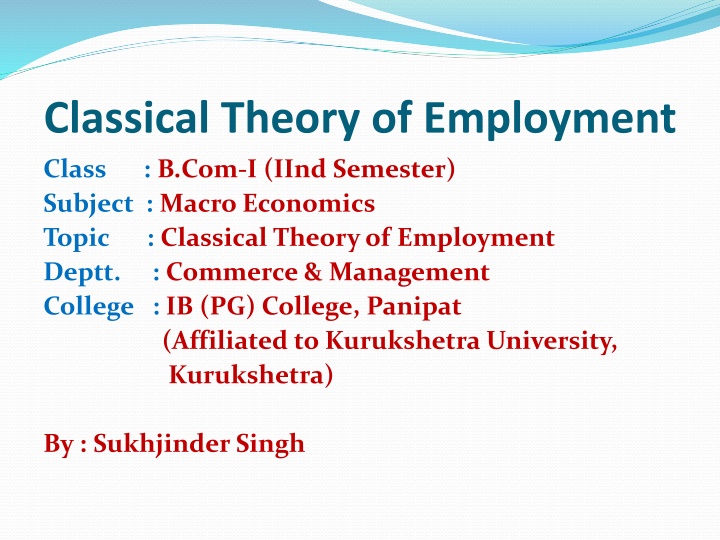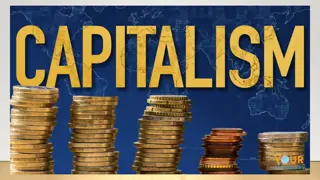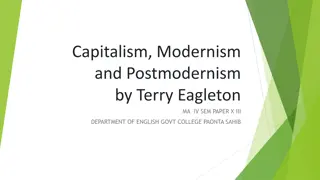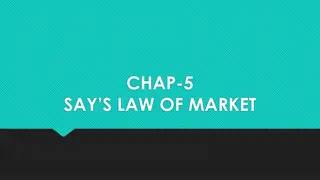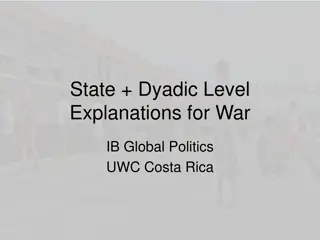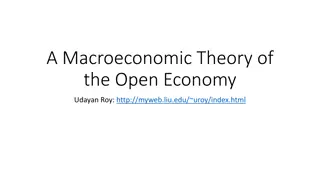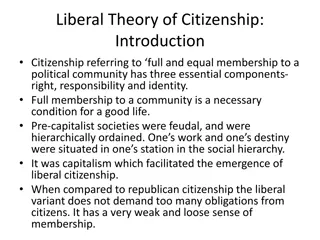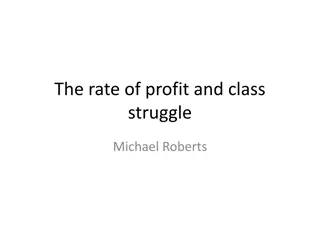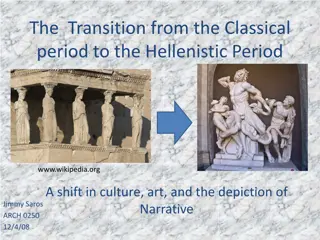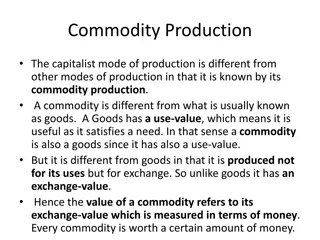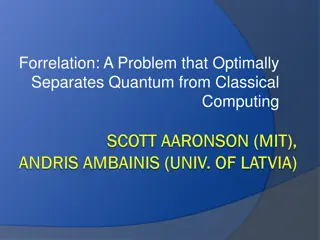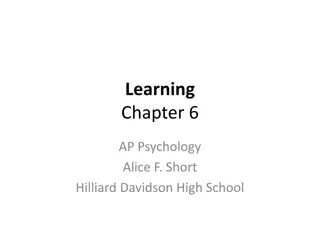Classical Theory of Employment in Capitalist Economy
Classical theory of employment in a capitalist economy focuses on full employment without inflation, with fluctuations due to economic forces. It explores concepts like natural rate of unemployment and types of unemployment.
Download Presentation

Please find below an Image/Link to download the presentation.
The content on the website is provided AS IS for your information and personal use only. It may not be sold, licensed, or shared on other websites without obtaining consent from the author.If you encounter any issues during the download, it is possible that the publisher has removed the file from their server.
You are allowed to download the files provided on this website for personal or commercial use, subject to the condition that they are used lawfully. All files are the property of their respective owners.
The content on the website is provided AS IS for your information and personal use only. It may not be sold, licensed, or shared on other websites without obtaining consent from the author.
E N D
Presentation Transcript
Classical Theory of Employment Class : B.Com-I (IInd Semester) Subject : Macro Economics Topic : Classical Theory of Employment Deptt. : Commerce & Management College : IB (PG) College, Panipat (Affiliated to Kurukshetra University, Kurukshetra) By : SukhjinderSingh
Introduction The term classical economists as used by Keynes refers to the traditional or orthodox principles of economics which have been handed down since the timeof early 19th century. The term classical economists was invented by Karl Marx to refer to Ricardo and his predecessors including Adam Smith. The classical analysis was based on Say's Law of Markets that "supplycreates its own demand."
What is Classical Theory of Employment? According to Classical Theory of Employment, Full employment is a normal feature of a Capitalist Economy. In other words, Economy remains in a state of full employmentwithout inflation. A situation of unemployment may arise for short period in which case the economic forces (Demand & Supply) working in the economy may themselves undergo such changes unemploymentdisappears. that the situation of
What is Full Employment? According to modern macro economics full employment refers to that situation wherein proper balance is struck between job-givers and job-seekers. Full employment is a condition of the national economy, where all or nearly all persons willing and able to work at the prevailing wages are able to work. Full employment means supply of labour is equal to demand for labour.
Natural rate of Unemployment Full employment is a situation in the economic system characterized by the absence of involuntary unemployment. Full employment does not mean that there is 'zero unemployment', some kind of unemployment may be found. It is called Natural rate of unemployment. Natural unemploymentand structural unemployment. unemployment, refers to frictional
Types of Unemployment Frictional Unemployment : Frictional unemployment exists when there is lack of adjustment between demand forand supplyof labour. It is also caused by lack of necessary skills for a particular job, labour immobility, shortages of raw materials, unemployment between losing one job and finding another is also included under frictional unemployment. Voluntary Unemployment: It means that situation wherein a worker is not willing to work even when work is availableat the prevailing wage rate. breakdowns of machinery, period etc. The of
ContdTypes Structural unemployment : Structural unemployment results from a variety of causes. There is shortage of capital, land etc. Workers are trained in old industries but they lack any proficiency . Production methods in the country undergo a change. Involuntary Unemployment: It refers to that situation in which people have to remain unemployed for want of opportunity for employment.
Assumptions There is a state of full employment. There is perfect competition in the product and labour markets. There is closed laissez faire economy. Money is a mere medium of exchange. Savings are always equal to investment. Interest rate is the very important and powerful factor which brings about an equality between savings and investment.
ContdAssumptions The quantity of money is given. Currency wages and actual wages have proportional relation. Short-run production function. Capital stock and technology knowledge are given. Wages and prices are flexible. The classical school considered only real factors and not monetary factors . Supply always creates its own demand.
Determination of full Employment and Output Classical theory asserts production depends on factors of production. Q= f(L, K, N, T) In the short period, capital(K), land(L) and technique(T) remain constant. Hence, volume of production depends upon the level of employmentor labour (N). Q = f(N) According to Classical theory level of employment are determine by the demand forand supply of labour.
Contd OS curve expresses production function. SS curve is supply curve and DD curve is demand curve of labour. Both curves intersect each other at point E. Hence, point E shows equilibrium point. OS number of labourers will be employed at OW wage rate. It expresses the position of Full Employment. There will be no involuntary unemployment in this situation. E
Explanation of the Classical Theory of Employment Classical Theory of Employment is mainly based on the following three planks : Equilibrium in Labour Market 1. 2. Equilibrium in Money Market 3. Equilibrium in Goods Market
Labour Market In the labour market, the demand for labour and the supply of labour determine the level of output and employment Demand for and supply of labourers depend on real wage rate (W/P). Real wage rate is calculated by dividing money wage by price level. Money Wage (W) Real Wage(W/P)= Price Level (P)
Labour Market Equilibrium Demand for labour is inversely related to real wage and supply of labour is an increasing function of the real wage rate. When the Dn and Sn curves intersect at point E, the full employment level Nf is determined at the equilibrium real wage rate W/Po. If the wage rates rises from W/P0 to W/P1 the supply of labour will be more than its demand by ds.
Money Market The money market equilibrium in the classical theory is based on the Quantity Theory of Money. According to classical economist the general price level (P) in the economy depends on the supply of money (M). Quantity theory of money is expressed in term of the following equation: MV = PT where, M= Supply of money, V= Velocity of money (Constant), P= Price level and T= Trade transactions (Constant) Relation between quantity of money and price level is one-sided
Equilibrium in Money Market AS is aggregate supply curve. It is vertical straight line. AD1 is initial aggregate demand cuts at point A and initial equilibrium output is OQ and OP is the price level. Due to fall in price level, full employment equilibrium will be restored at point C (via, ABC) Due to rise in price level, full employment equilibrium will be restored at point E (via, ADE)
Goods Market The goods market is in equilibrium when saving equals investment. At that part of time, total demand equals total supply and the economy is in a state of full employment. According to the classicists, what is not spent is automatically invested. Thus saving must equal investment. If there is any divergence between the two, the equality is maintained through the mechanism of the rate of interest.
Contd According to classical, both saving and investment are the functions of the interest rate. S = f(r) ..(I) where, S = Saving and r = rate of interest I = f(r) .(II) where , I = investment S = I The higher the r , the higher the S, and lower the I. on the contrary, the lower the r , the higher the demand for investment and lower the S. If at any given period, I > S the rate of interest will rise . If at any given period, I < S the rate of interest will low .
Equilibrium in Goods Market I and S both intersect at E which is the full employment level where at Or intersect S = I Since S > I, the investment demand for capital being less than its supply, the interest rate will fall to Or2 investment will increase and saving will decline. Consequently, S = I equilibrium will be re-established at point E and vice versa.
Criticism of Classical Theory Refutation of say s law Underemployment equilibrium Invalidity of Quantity Theory of Money Rejection of Laissez-Faire Policy Self-adjustment is not possible Supply of labour not a direct function of Real Wages Saving and investment are not interest elastic
